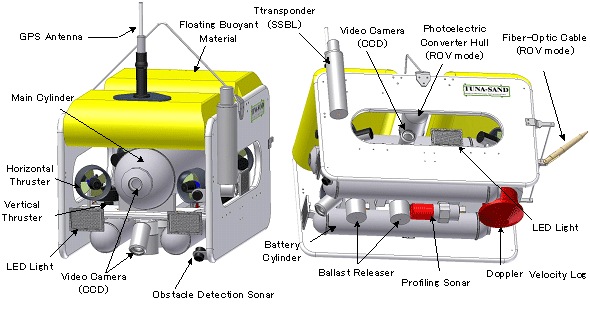 |
 |
|
|||||||||||||||||||||||||
|
| Ocean Floor Probe with Automatic and Remote-controlled Operation |
Tamaki Ura, Chief of Institute of Industrial Science I am working on the development of a robotic probe to explore natural resource on the seafloor. The exploration of natural resources on the seafloor typically involves the following steps; (1) highlight promising areas with on a map of the seafloor, (2) obtain core samples ( column core) over several kilometers and analyze for volcanic sediment to focus the investigation area, (3) survey a 100m order grid using self-controlled robot (AUV; Autonomous Underwater Vehicle) to pinpoint spots likely to contain mineral deposits, (4) identify the deposits directly using images or pictures sent from a tethered remotely controlled submersible (ROV; Remotely Operated Vehicle) or a manned submersible. Thus, to date, seafloor exploration required the deployment of several robots, including both AUVs and ROVs. In order to achieve these tasks with just a single robot, we developed the robotic ocean probe "TUNA-SAND; Terrain base Underwater Navigable AUV for Seafloor And Natural resources Development"TUNA-SAND can function as an AUV, or as a ROV since it is equipped with a removable fiber optic cable so that it can be remote-controlled if required. While viewing images transmitted during fully automatic controlled operation, the operator can override and switch to remote-control operation depending on the situation at hand, in order to perform more detailed investigations. This innovation makes it possible to overcome the major disadvantage of AUVs, making it possible make real-time decisions to focus investigations on specific target areas as required. TUNA-SAND performed excellently during its seafloor inspections between 16th-26th August 2007. It discovered vigorous spring s of hot water at 200m depth on the seafloor of Kagoshima bay. Of particular significance was the discovery of a 3m high volcanic chimney. These dives were the first time video images of the hot water activity had been taken by a AUV/ROV hybrid. |
My ideal is to develop robots that can go on exciting adventures, like Astro Boy hanging on the wall of my laboratory. The robots should go to places where people cannot go and do things that people cannot do. Once a particular challenge has been cleared, the robots should move on to the next, more difficult, challenge. I want our young students to also take risks and challenges, just like the robots, as I believe that only by struggling together with the robots, can they also truly share and enjoy the success of their achievements. There are two types of challenges facing underwater robots. The first is how to cover larger areas, and the other is how to pinpoint specific targets. For survey of broad area, the AUV is unrivalled in its capabilities and is ideally suited to the challenge. On the other hand, for pinpoint observations, ROVs and manned submersibles are better suited. TUNA-SAND can combine the advantages of both. The next mission for TUNA-SAND is to explore Myojinsho caldera in March 2008. Myojinsho symbolizes both the beauty and the terrifying nature of our seas, on the one hand it's seafloor deposit contains a wealth of natural resources and on the other hand, it is a highly active underwater volcano that has clamed several lives. TUNA-SAND will go on a new adventure to explore the mineral deposits of Myojinsho. Here, TUNA-SAND will reach its maximum depth rating of 1500m, which was designed specifically for exploration of Myojinsho. In time the aim is to equip TUNA-SAND with manipulators for sampling, so that it can independently handle any situation. I am excited to see our robots take on new adventures. |
 TUNA-SAND; Terrain base Underwater Navigable AUV for Seafloor And Natural resources Development Functioning as AUV and ROV 1.1m (length) X 0.7m (width) X 0.71m (height, except antenna) 240kg (in the air),1500m (maximum submerge), 2.5knots (Maximum speed) |

<Personal Background> 1977:Doctor of Eng. of naval architecture of postgraduate course of Univ. of Tokyo 1978: associate prof. of institute of industrial science of Univ. of Tokyo 1992: prof. of the institute. 1999: director of underwater technology res. center . Prize of the society of naval architects of Japan(1979, 1994, 1997) Prize of technology of the Society of mechanical engineers of Japan (1999) and others. |
| <<Back | Page top |